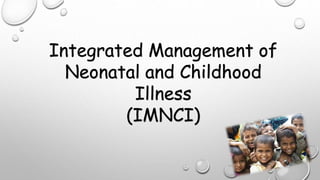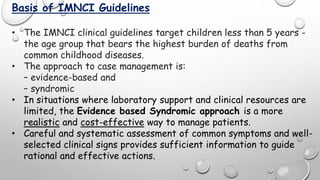The document provides information on the Integrated Management of Neonatal and Childhood Illness (IMNCI) strategy developed by WHO and adapted in India. It notes that children under 5 bear the highest burden of deaths from common diseases. The main causes of death are respiratory infections, diarrhea, malaria, measles and malnutrition. IMNCI aims to integrate services for better clinical outcomes. It focuses on treating the main symptoms in sick children and infants through evidence-based guidelines using limited clinical signs and essential drugs. The guidelines help assess health problems, severity and appropriate care. IMNCI aims to reduce mortality, illness and improve growth through improved case management and health system and family/community support.
























